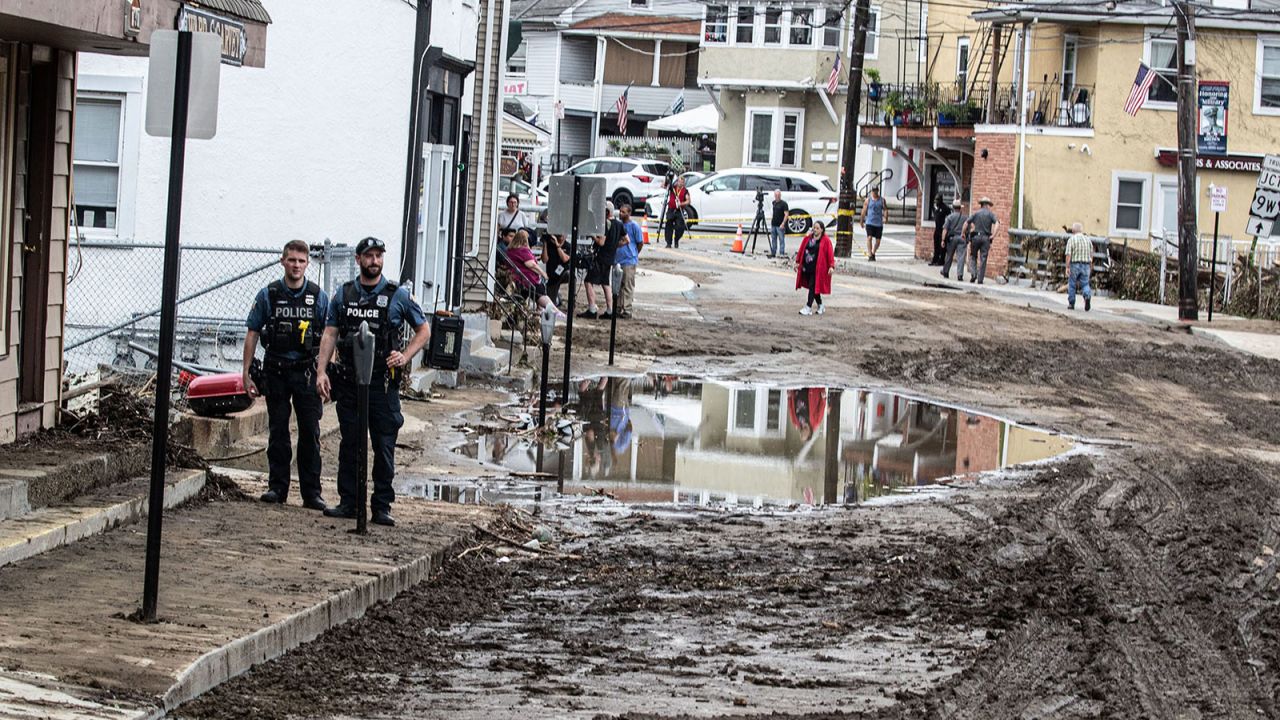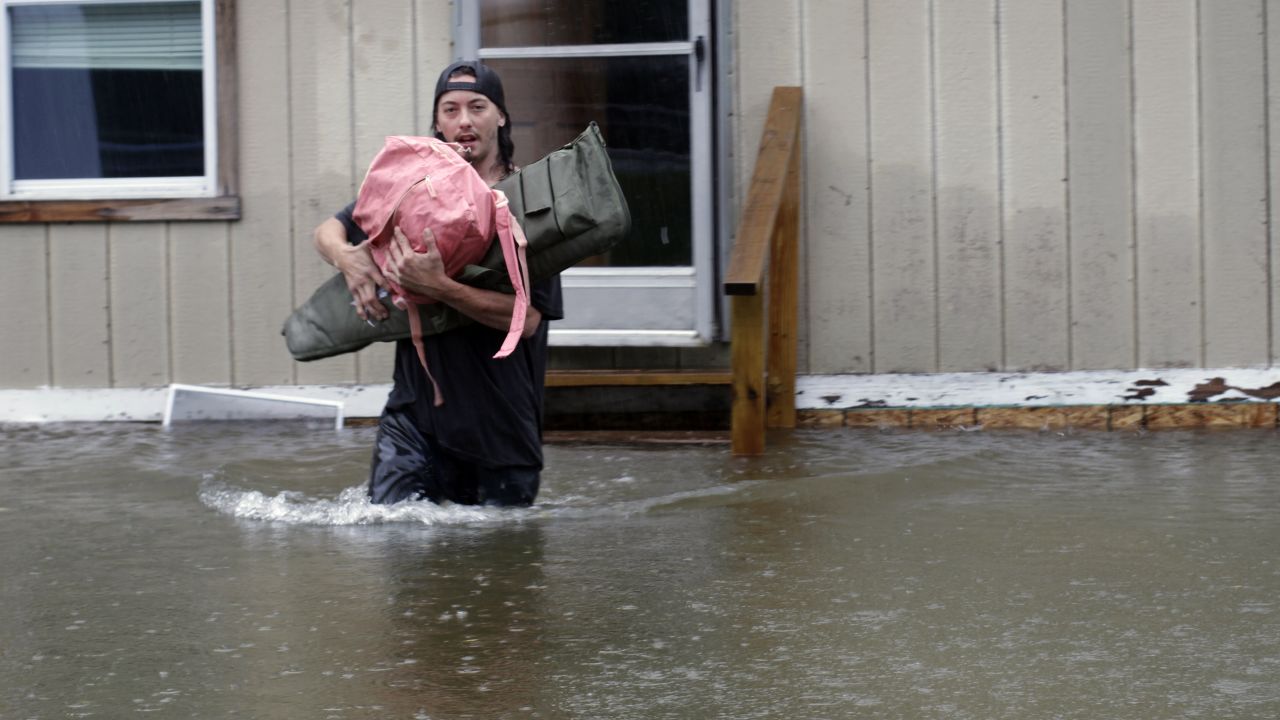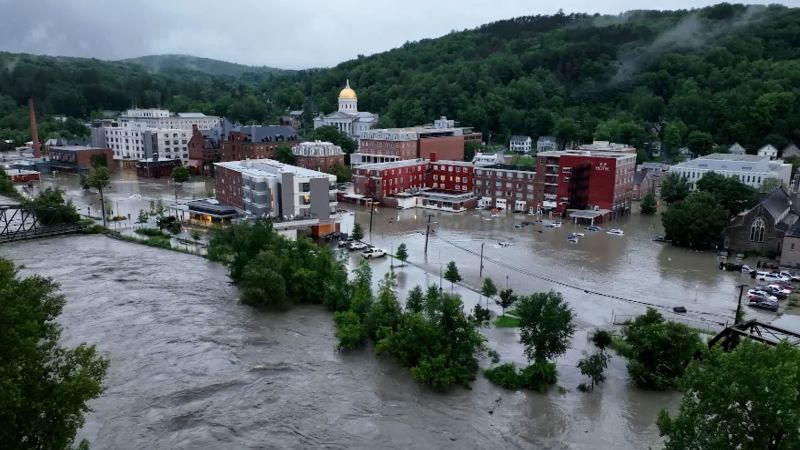CNN
—
Intense rainstorms inundating the Northeast are turning streets into rivers, forcing evacuations and have prompted officials in Vermont’s capital, Montpelier, to close the city’s downtown area.
The catastrophic flooding threatening Vermont has drawn comparisons to Hurricane Irene in 2011, which left entire communities submerged and killed more than 40 people in the eastern US. While water is beginning to recede in downtown Montpelier, a travel ban for the area has been extended until 3 p.m. Tuesday. The city was hammered by a record-setting 5.28 inches of rainfall Monday, the National Weather Service in Burlington said.
That’s more than any other day on record, including when Hurricane Irene dropped 5.27 inches of rain on the state capital on August 28, 2011. The nearby city of Barre also shut its downtown due to the flooding.
The Montpelier Police Department relocated its dispatch, police and fire operations due to heavy flooding in the basement of City Hall and the fire and police departments, Police Chief Eric Nordenson said Tuesday. Three radio towers used to dispatch fire and ambulances in Washington County have been compromised by the flooding, he said.
Montpelier City Manager William Fraser warned a “potentially dangerous situation” is facing the state capital.
“The Wrightsville Dam only has 6 feet of storage capacity left. If water exceeds capacity, the first spillway will release water into the North Branch River,” Fraser said in a Facebook post.
“This has never happened since the dam was built so there is no precedent for potential damage. There would be a large amount of water coming into Montpelier which would drastically add to the existing flood damage,” Fraser said. “Unfortunately, there are very few evacuation options remaining. People in at risk areas may wish to go to upper floors in their houses.”
Water levels at the dam are being monitored, and it’s possible that spillover will affect water levels downtown, Nordenson said.
With water in downtown Montpelier running from knee to waist deep, residents stranded in their homes and businesses and roads closed, Fraser told CNN the situation is looking much worse than it did in the 2011 flooding.
Vermont, New Hampshire and Maine are under a lower risk for excessive rainfall than they were Monday, but the threat of flooding persists.
Flood alerts affecting over 2 million people across parts of New England and Oklahoma expired Tuesday, but flood warnings remain in both regions.
“Just because the rain has stopped in some areas, does not mean the threat of flooding has gone away,” Vermont Gov. Phil Scott warned in a tweet Tuesday. “Stay vigilant and stay updated.”
Officials are working to address damage and urgent needs in Vermont and New York, which suffered the brunt of the flooding Monday. The flooding left at least one person dead in New York’s Orange County.
The situation in Vermont highlights the potential for catastrophic flooding that has not been seen in this part of the country since 2011,” the National Weather Service said.

“We have not seen rainfall like this since Irene, and in some places, it will surpass even that,” Scott said Monday. Vermont remains under a state of emergency, after flooding forced evacuations and more than 100 rescues in the state, Vermont’s Urban Search and Rescue manager Mike Cannon told CNN.
One of the search and rescue teams has been stuck in a heavily flooded area in the north branch of the Winooski River since Monday, Cannon said, adding that five National Guard helicopters are coming in to assist.
Two areas in the state, Weston and South Londonderry, were left inaccessible Monday due to flooding, according to Cannon.
Betsy Hart called 911 when the floodwaters suddenly started rising fast Monday at the basement of her Chester property in Windsor County.
“Water was rising quickly after being pretty tame most of the morning,” Hart told CNN’s Miguel Marquez. “All of a sudden it was in the house.”
Hart said she’s never experienced flooding like what she saw Monday. “It was too close for comfort,” she said.
“With Hurricane Irene, the water was raging like this, but it never really got to the house,” she said, standing on a road near her home as water rushed nearby.
Numerous rivers across Vermont have been rising amid the downpours, with some swelling higher than levels reached during Hurricane Irene. The Winooski River at Montpelier rose nearly 14 feet Monday and passed major flood stage as the water continued to climb, threatening further flooding.
Nearly a dozen different areas across Vermont, from the Connecticut River in the south to the Missisquoi River in the north, were expected to see moderate or major flooding before rivers begin dropping later Tuesday.
Vermont’s Ball Mountain Dam and the Townshend Dam, are expected to overflow their spillways early Tuesday morning and “release unprecedented quantities of water,” the US Army Corps of Engineers warned Monday night. Warning of “severe flooding,” the agency urged residents in threatened low-lying areas of nearby Vermont and New Hampshire communities to evacuate.
In New York, where six counties are under a state of emergency, a 35-year-old woman died after being swept away by floodwater as she tried to evacuate her Orange County home Sunday. The flooding has caused “easily tens of millions of dollars in damage,” county Executive Steve Neuhaus said Monday.
Some areas in New York were hammered with more than 8 inches of rain within a 24-hour period.
New York Gov. Kathy Hochul said the state will likely meet the threshold of $37 million in statewide damages and become eligible to receive funding from FEMA.
“You can see highways, roads and bridges that are still unpassable, homes that have been destroyed. We still have people without power and as we talked about earlier, one woman actually lost her life, so it is still treacherous in many of these regions,” Hochul said.

Seven-day rainfall totals across much of the Northeast are already at 300% to 500% of normal levels, the Weather Prediction Center said.
Widespread rainfall of 2 to 4 inches has fallen across the Northeast from eastern Pennsylvania and northern New Jersey into Vermont and New Hampshire. Isolated rainfall totals higher than half a foot have been seen in several states.
In Vermont, the storms battered Mount Holly Heights with a whopping 8.66 inches of rain and Tyson with 8.40 inches.
Meanwhile, Stormville, New York, received 8.61 inches while West Point – where drivers had to swim out of their cars Sunday – got 8.12 inches.
Rainfall in West Point totaled more than 7.5 inches in a six-hour period Sunday afternoon, according to preliminary data from the National Oceanic and Atmospheric Administration. That’s a 1-in-1,000 year rainfall event for the area, according to a CNN analysis of NOAA’s historical rainfall frequency data.
Elsewhere, South Kent, Connecticut, got 6.80 inches, and West Lawn, Pennsylvania got 6.69 inches.

Vermont State Rep. Kelly Pajala said she woke up Monday morning to flood water already at the front step of her Londonderry apartment. She and her son packed up their two cats and evacuated to higher ground.
“For people that were here during Irene, it feels like a very similar experience,” she said. Hurricane Irene brought destructive flooding to the state in 2011, causing major infrastructure damage.
Flood water could be seen gushing between homes in Chester, where some structures were visibly damaged and trucks were wheels-deep in water.
Don Hancock, dripping in water from head to toe, told CNN he has only lived in his Chester house for less than a year and watched floodwater enter the basement and garage of his new home.
“I was a firefighter in New York. I’ve been there many of times to help people out, but I’ve never lived this side of it,” Hancock said.
Now, he’s just waiting for the water in his neighborhood to recede. “Once the water goes down, we go day by day, clean it up and move on. What can we do?” Hancock said.
Windham and Windsor counties have been the hardest hit by the flooding, according to Cannon, from the state’s Urban Search and Rescue Program.
Officials have made 50 rescues across Vermont, including using boats to help people trapped in their homes or in cars that were swept away in fast-moving waters.
The state of California is also deploying urban search and rescue personnel to assist emergency response efforts as Vermont grapples with flooding, according to a Monday tweet from the California governor’s office.
Crews from Michigan, Massachusetts, New Jersey and Connecticut are on their way to assist as well.
Credit: Source link


































